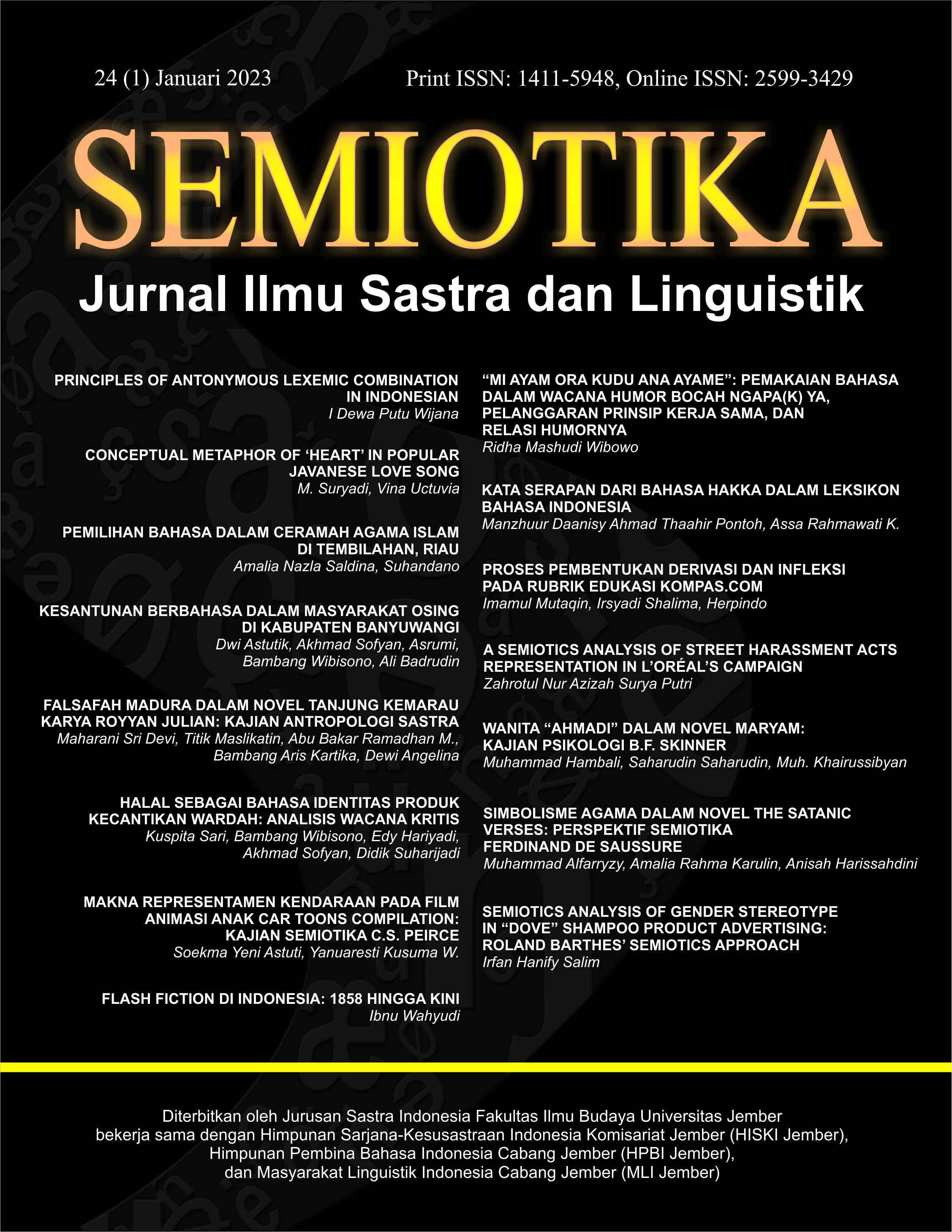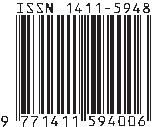KATA SERAPAN DARI BAHASA HAKKA DALAM LEKSIKON BAHASA INDONESIA
DOI:
https://doi.org/10.19184/semiotika.v24i1.31095Keywords:
Etymology, Hakka Chinese, Indonesian, Loanwords, Semantic changeAbstract
Indonesian language borrowed heavily from languages spoken inside Indonesian territory. The borrowing is caused by language contact between Malay (and now Indonesian) and other languages, including several Sinitic languages that have been spoken for centuries in Indonesia. Hakka Chinese is one of the largest Sinitic languages in Indonesia by the number of speakers, therefore borrowing from Hakka Chinese in Indonesian is bound to happen. The aim of this research is to find borrowings from Hakka Chinese in Indonesian lexicon, also to find semantic changes in those borrowings. Methods in finding the borrowings started from compiling all the possible Hakka loanwords from Hakka lexicons into a wordlist. The wordlist is verified by native Indonesian Hakka Chinese correspondent, and then compared to lemmas in the Kamus Besar Bahasa Indonesia (KBBI) to find any semantic changes. We found that there are 44 loanwords from Hakka Chinese in Indonesian, of which 15 words had semantic changes and 29 others have not any semantic changes.
Downloads
References
(Daring). https://kbbi.kemdikbud.go.id/. Menurut pemutakhiran April 2021.
Bloomfield, L. 1973. Language (cetakan ke-11). London: George Allen & Unwin.
Chappell, H. & Lamarre, C. 2005. A Grammar and Lexicon of Hakka: Historical Materials
from the Basel Mission Library. Paris: Centre de Recherches Linguistiques sur l’Asie
Orientale.
Durkin, P. 2009. The Oxford Guide to Etymology. New York: Oxford University Press.
Haugen, E. 1950. “The Analysis of Linguistic Borrowingâ€. Language, 26 (2):210—231.
Herman å”æ ¹åŸº. 2017. ‘å°å°¼åŽä¸æ±‰è¯å€Ÿè¯çš„ç§ç±»ç ”究 Penelitian Jenis-Jenis Kata Serapan
Bahasa Tionghua dalam bahasa Indonesia’. Jurnal Cakrawala Mandarin, 1 (1):96—
115.
Huang Huizhen é»ƒæƒ ç. 2008. å°å°¼å±±å£æ´‹å®¢å®¶è©±ç ”究 Yinni Shankouyang Kejiahua Yanjiu.
Disertasi. Taoyuan: Gouli Zhongyang Daxue.
Jones, R. 2008. Loan-words in Indonesian and Malay. Jakarta: Yayasan Obor Indonesia.
Kong Yuan Zhi. 1987. “A Study of Chinese Loanwords (from South Fujian Dialects) in the
Malay and Indonesian Languagesâ€. Bijdragen tot de Taal-, Land- en Volkenkunde, 143
(4):452—467. URL: https://www.jstor.org/stable/27863866
Kridalaksana, H. 1982. Kamus Linguistik. Jakarta: Gramedia.
Li Xiaohua æŽå°åŽ. 2014. å°å°¼å®¢å®¶â€¢æ–¹è¨€ä¸Žæ–‡åŒ– Yinni Kejia: Fangyan yu Wenhua.
Guangzhou: Huanan Ligong Chubanshe.
Matras, Y. 2009. Language Contact. New York: Cambridge Univerity Press.
McIver, D. 1905. “客英大è¾å…¸ A Chinese-English Dictionary: Hakka-Dialect as Spoken in
Kwang-tung Provinceâ€. Diakses melalui situs web Min and Hakka Language Archives:
http://minhakka.ling.sinica.edu.tw/bkg/index.php
Pateda, M. 2010. Semantik Leksikal (ed. 2). Jakarta: Rineka Cipta.
Rao Bingcai 饶秉æ‰. 2000. “客家音å—å…¸ (普通è¯å¯¹ç…§) Kejia Yin Zidian (Putonghua
Duizhao)â€. Guangzhou: Guangdong Renmin Chubanshe.
Schaank, S.H. 1897. Het Loeh-foeng-dialect. Leiden: E. J. Brill.
Tim Penyusun Kamus Pusat Bahasa. 2008. Kamus Besar Bahasa Indonesia edisi IV. Jakarta:
Pusat Bahasa.
Weinreich, Uriel. 1979. Languages in Contact: Findings and Problems. The Hague: Mouton
Publishers.
Wen Changyan æ¸©æ˜Œè¡ (ed.). 2006. 客家方言 Kejia Fangyan. Guangzhou: Huanan Ligong
Daxue Chubanshe.
Xu Jianfang å¾å»ºèŠ³. 2015. 《客語陸è±æ–¹è¨€ã€‹ä¹‹è¯æ ¡å•é¡ŒæŽ¢æž <Keyu Lufeng Fangyan> zhi
Yi Jiao Wenti Tan Xi. Laporan Riset. 客家委员会 Kejia Weiyanhui (Lembaga Urusan
Hakka, Taiwan).
Zhang Zhenxing å¼ æŒ¯å…´ (ed.). 2012. ä¸å›½è¯è¨€åœ°å›¾é›† (第 2 版):汉è¯æ–¹è¨€å· Zhongguo
Yuyan Ditu Ji (Di Er Ban): Hanyu Fangyan Juan. Beijing: The Commercial Press.
Downloads
Published
Issue
Section
License
SEMIOTIKA has CC-BY-SA or an equivalent license as the optimal license for the publication, distribution, use, and reuse of scholarly work. Authors who publish with this journal retain copyright and grant the journal right of first publication with the work simultaneously licensed under a Creative Commons Attribution-ShareAlike 4.0 International License that allows others to share the work with an acknowledgment of the work's authorship and initial publication in this journal.
Attribution-ShareAlike
CC BY-SA








